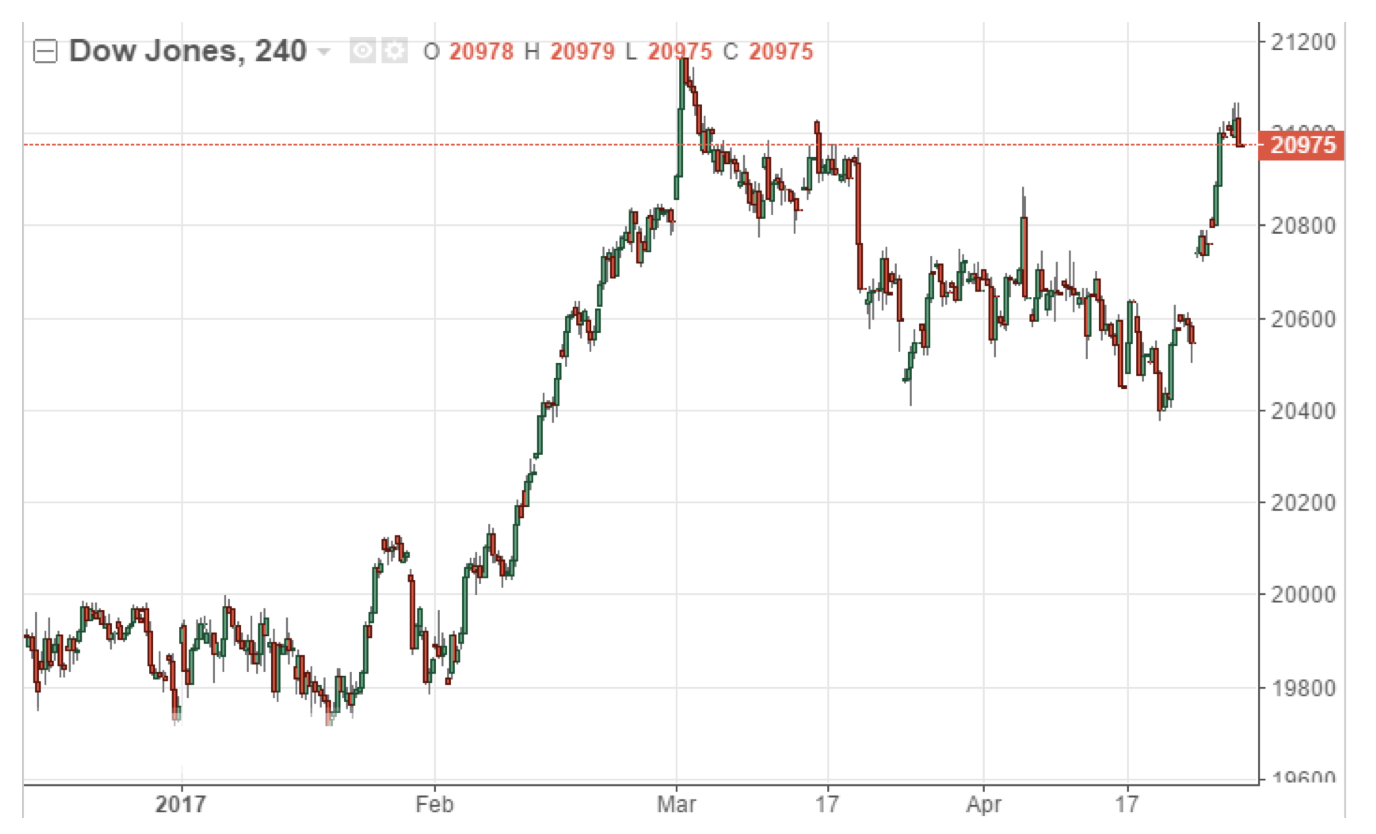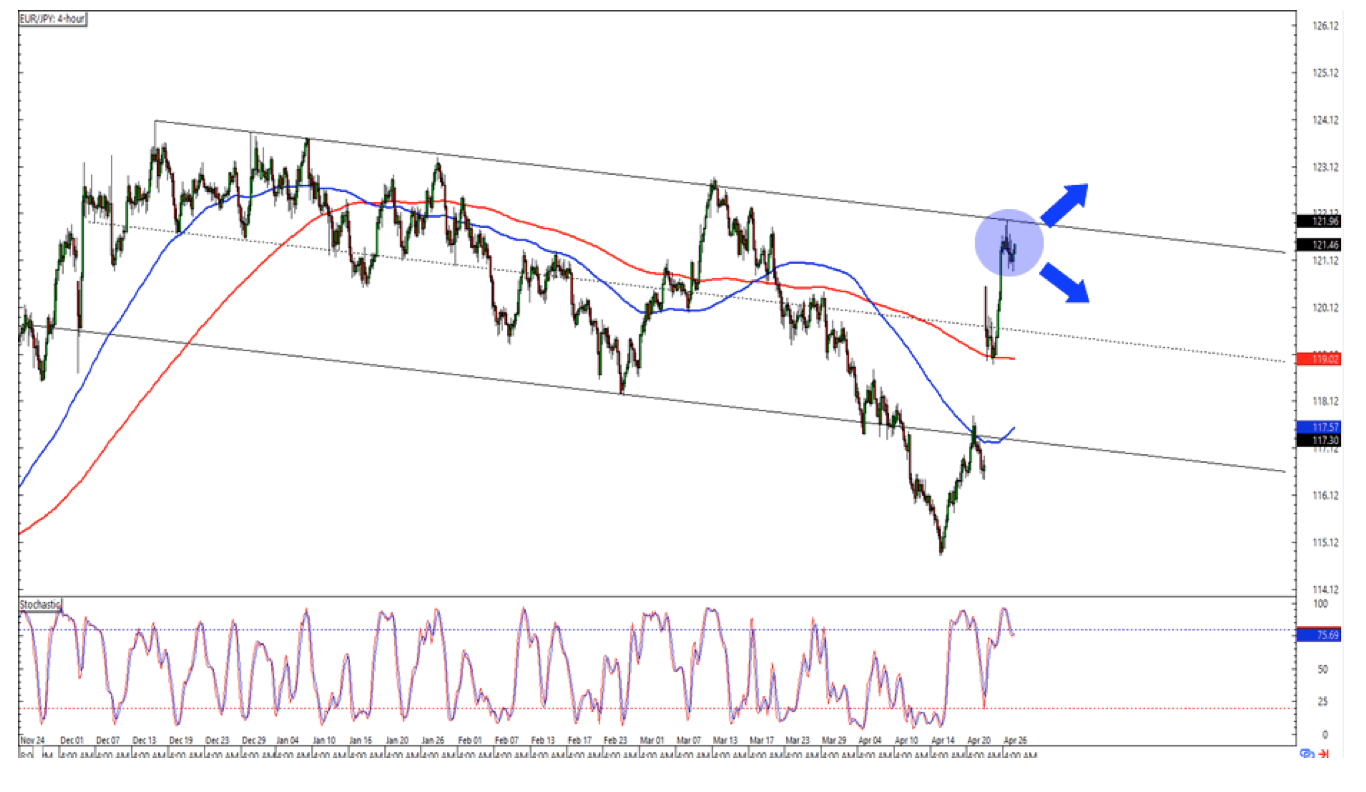Daily Insights Report 27/04/17
- 27 Apr 2017
US Equity markets closed lower on Wednesday after the Trump Administration announced a reduction in the corporate tax rate to 15% and a one-time tax on money held by corporations overseas. These tax proposals are broadly in line with what markets had been expecting. As a result of this release, the Dow Jones Industrial Average lost 21 points, which is the equivalent of 0.1%. The below chart depicts the situation of the DJIA.

– The Euro initially fell to $1.0857 as the currency took a pause from this week’s rally, which was largely based on fading risks from within the Eurozone. Markets priced in a victory for centrist Emmanuel Macron in the French presidential election. However, the Euro rebounded back up to $1.0907 after the release of Mr. Trump’s proposals, although it was still down 0.2% against the Dollar on the day.
– The US currency reversed an early rise against the Yen to 111.77 to trade flat at 111.07.
– The Dollar gained 0.3% against the CAD since there is new uncertainty about the future about NAFTA (North American Free Trade Agreement).
– The AUD was 0.9% weaker against the USD at $0.7468 after consumer price data for the March quarter showed that inflation had re-entered the central bank’s target range for the first time since 2014.
Commodities
– Early strength for the US energy stocks faded as the price of Brent oil came out of negative territory. This comes after data released by the EIA (Energy Information Administration). Brent settled at $51.82, which is still down 0.5% than what it saw during the day. West Texas Intermediate (WTI) crude on the other hand was down 0.6% to reach $49.27 after passing $50 for a short period on the day.
– Gold moved higher as the dollar lost some of its strength. It rose $6 from Tuesday’s two-week low to trade at $1,269 an ounce.
United States Dollar (USD)
University of Michigan Survey (April)
The University of Michigan’s consumer sentiment index is expected to have come in at 97.5 in April, which is modestly below its preliminary estimate but still above March’s reading of 96.9. Stocks and gasoline are likely those that have weighed on sentiment. Unlike other measures of sentiment, there isn’t strong evidence of a political bias in any of the measures of consumer sentiment. Therefore, consumer sentiment may be too strong relative to core fundamentals. If sentiment weakens more, it wouldn’t have a significant impact on the outlook of the overall economy.
Euro (EUR)
Euro Zone Preliminary Consumer Price Index (April)
Euro zone annual harmonized inflation likely accelerated to 1.6% in April from 1.5% in the previous month. Inflation should not spike too much in the longer term, and it is likely that it has already reached this year’s high. Besides subdued headline figures, next week’s release will likely show that core inflation remains low, especially in southern European countries. Softer wage growth due to higher unemployment is creating a low-inflation environment.
German Unemployment (April)
Germany’s seasonally adjusted unemployment rate likely remained at 5.8% in April, after falling to this new record low in March. German businesses remain confident in the country’s future expansion, increasing their labor force, even though there are uncertainties and geopolitical tensions. Details of the latest Markit manufacturing PMI showed the rate of hiring accelerating to one the fastest since July 2011. The weak Euro has also supported demand for German products from outside of the single-currency area, which should translate into higher employment. However, the unemployment rate is likely nearing the lowest level as it is expected to increase somewhat later this year because of the vast inflow of refugees since mid-2015, some of whom will be entering the German labor force.
Technical Analysis
EURJPY
Looking at the 4-hour chart of this currency pair we can see that the pair is struggling to pass the 121.50 level – which is in the middle of the falling channel. Looking at the stochastic indicators, it can be seen that the pair is in oversold territory. This could suggest that the Euro is likely to weaken. A viable strategy at current levels would be to short the currency aiming at the bottom of the channel.


